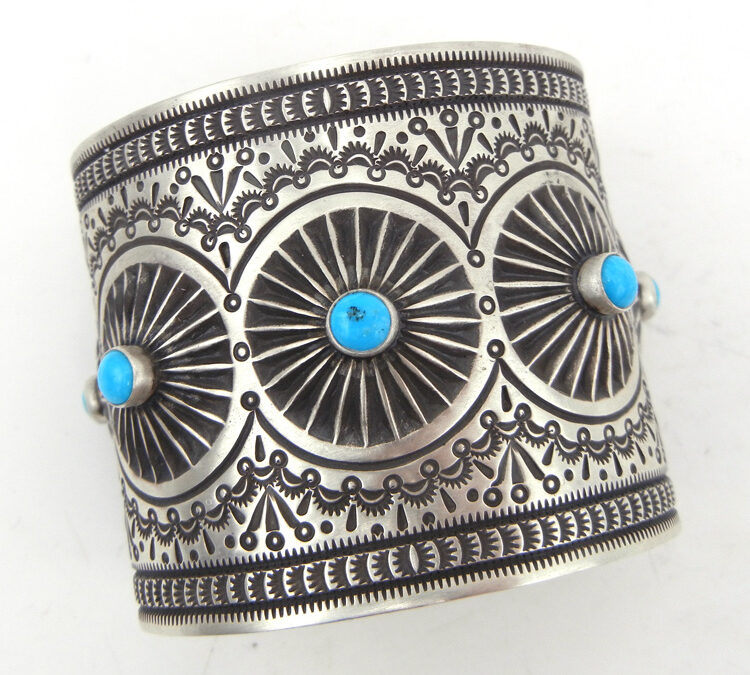Almost every North American native tribe has used their influences to design unique and meaningful bracelets. The Navajo are no exception.
What may be surprising are the influences that incoming tourists and settlers had on the innovations of Native American bracelet design. We’re focusing on Navajo bracelet design, but the Zuni’s jewelry was also heavily influenced by incoming settlers.
At Palms Trading Company, we want to give you the stories behind Navajo bracelets. From the Spaniards’ silversmithing techniques to the abundance of turquoise mines, you’ll see how Navajo bracelet design evolved with each event.
When you’re wearing one of these bracelets, you’re truly wearing a piece of evolution.
Navajo Silversmithing
Atsidi Sani (Old Smith) was a Navajo blacksmith living in the 1800s. As the Spaniards entered the North American southwest regions, Atsidi Sani was mesmerized by what he saw. The Spanish and their horses were adorned with shiny, silver embellishments never seen by the Navajo before.
Determined to learn how to make these adornments, Atsidi Sani convinced a Spanish silversmith to teach him this art. Atsidi Sani initially made conchas and bracelets to be sold to the Spaniards, but his Navajo community also was interested in acquiring these pieces.
To meet the growing demand, Atsidi taught his four sons and younger brother, Slender Maker of Silver, to silversmith. Towards the late 1800s, Slender Maker of Silver and Atsidi Chon were said to be the first Navajo silversmiths to use turquoise in their creations.
Early Navajo Bracelet Design
From 1880 to 1900, Navajo bracelets were heavy and simply made. The tools used to make these bracelets were also basic such as awls, hammers, chisels, and files.
Without a source for pure silver, the Navajo used the metals of US and Mexican coins. They melted these coins and then pounded the ingots into flat sheets. Ingots are metal blocks, often oblong in shape.
Engravings were scratched into the metal’s surface by rocking a chisel.
The Navajo also employed casting techniques to make bracelets. Melted metals were poured into molds carved from tufa stone and left to harden.
Soon, Navajo artisans began using soldering techniques to enhance bracelet designs. Triangles, twisted wire, and flat bars were now added to bracelet bands.
Transcontinental Railroad
In the late 1800s, the transcontinental railroad brought traders and tourists into the southwest regions. Amongst these traders was the Fred Harvey Company.
This company gave the Navajo better tools, such as saws, shears, and finer files. Navajo silversmiths were now able to create more delicate pieces. Mexican leather influenced stamp designs which now decorated bracelet bands.
Moving forward, Fred Harvey Company’s interest in fulfilling tourist demand would soon bring a complete revolution in Native American bracelet design and manufacturing.
Herman Schweizer
Herman Schweizer was a buyer for Fred Harvey Company and often purchased Navajo bracelets to sell in Harvey House stores. When noticing that tourists wanted smaller, lighter bracelets to wear, Schweizer began plans to evolve the current Navajo design.
First, Schweizer began supplying traders with precut turquoise and silver sheets. These traders then employed Navajo silversmiths to create “authentic Indian” designs.
These early 1900s creations consisted of silver bands stamped with elements like arrows, lizards, and thunderbirds. These bracelets also featured a single turquoise or agate stone.
As demand for these bracelets increased, merchants in Albuquerque and Santa Fe created shops employing non-Native American workers to mass produce this design. The backlash against this mass production halted these practices, but the mass-produced bracelets are still collected and valued today.
Nevada and Colorado Mines Open
From the 1920s to 1940s, the opening of Nevada and Colorado turquoise mines signaled another design revolution. Now that turquoise was more available, Navajo silversmiths began using more turquoise in their bracelet designs.
This era saw the most complex and ornate designs produced by Navajo silversmiths. Silver bracelets now featured one prominent turquoise stone in the middle with smaller stones running down the sides.
Some bracelets featured three large turquoise stones wrapped in twisted wire and decorated with silver raindrops, feathers, and leaves. Saw-tooth and scallop-shaped bezels also became prominent.
Influenced by Zuni design, Navajo artists experimented with cluster style and multiple-row bracelet arrangements.
Navajo and Zuni Connection
It’s not surprising that Zuni techniques inspired later Navajo bracelet designs. In fact, the two tribes have much in common when it comes to jewelry evolution.
Remember Atsidi Chon? While traveling through Zuni lands, Atsidi Chon taught the Zuni how to silversmith. Though initially using these skills to create tools, Zuni artisans realized they could use this technique to make jewelry.
Much like the Navajo, the Zuni’s jewelry revolution came in the 1930s through tourist demand. A trading post owner named C. G. Wells gave the Zuni tools and materials to work. He encouraged the Zuni to use turquoise in their jewelry creations to please tourists.
Today, C. G. Well’s influences can still be seen in Zuni jewelry in the form of turquoise and other precious stones used.
Navajo Bracelets Today
Today, traditional methods have merged with modern designs. Navajo bracelets come in gold and silver. Bands are wide and thin. They can be hammered or cast. Designs are inlaid and stamped. Also, a wider array of stones are used, such as coral, spiny oyster, malachite, onyx, and lapis. The list is endless.
Despite having access to more stones, turquoise remains the most prominent stone used in Navajo jewelry.
Where to Buy Native American Bracelets
At Palms Trading Company, we offer the best selection of Native American bracelets from the Navajo, Zuni, and Hopi tribes. We buy directly from the artists, ensuring that the pieces we sell are authentic. We also certify the stones in the bracelets so you know that your turquoise is genuine.
Check out our store in Albuquerque or shop with us online to find your piece of Navajo evolution.



